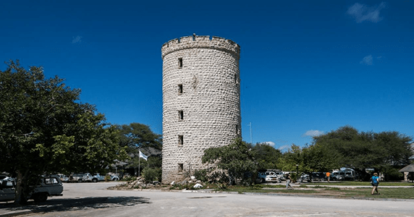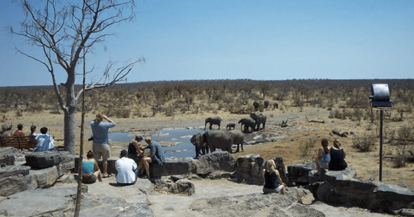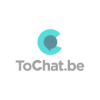BON VOYAGE!!!
Your Total Amount for the 4 days’ safari:
Per Person Sharing = NAD/ZAR 11 531.00
INCLUDED / EXCLUDED
Includes:
– Accommodations
– Vehicle (Manual Toyota Hilux 4 x 4 or similar)
– Park Entrance Fee
– Meals as stated
Excludes:
– Local and International flights
– All expenses of a personal nature
– Visa Fees
– Tips and Gratuities
– Personal insurance
– Activities
Travel Info
Namibia is situated in the South – Western corner of Africa and is a land of remarkable contrasts. Despite its size (four times the size of Great Britain), It is sparsely populated with an estimated population of 2.1 Million people. The small population is largely due to the arid conditions, with a national average rainfall of 270mm per year.
Visa: It is advisable to double –check visa requirements for your country of origin prior to travelling Visas are valid for up to three months from date of entry.
Time Zone: GMT+-2 in the summer (the first Sunday in September to the first Sunday in April);
GMT+-1 in the winter (the first Sunday in April to the first Sunday in September)
Electricity: 220volts AC50hz
Mobile Phones: Mobile communication system is GSM, roaming agreements exist with most international mobile phone operators. Coverage is limited areas.
Internet: There are internet cafes situated throughout the country and most hospitality establishments offer an internet service.
Shopping: Windhoek and Swakopmund offer a selection of stylish shops. Local crafts are sold in specialised, shops, as well as at street markets, most shops are open from Monday to Saturday, with selected shops and street markets open daily.
Money: The Namibian Dollar (NAD: symbol N$) is the country’s official currency.it is equivalent to the South African Rand which is also legal tender in Namibia.
Currency Exchange: Traveller’s cheques can be exchanged during normal banking hours at any of the commercial banks, or at bureau de change offices.
Credit Cards: American Express, Diners Club, MasterCard and Visa are accepted. Check with your credit/debit card company for details of merchant acceptability and other services which may be available. Credit cards are not usually accepted at petrol station. ATM’s for cash withdrawal are readily available in all towns.
Air Travel: The National airline is Air Namibia, offering daily flights from Frankfurt to Windhoek. British Airways, South African Airways, Air Berlin and TAAG also fly to Namibia. Flying time from Frankfurt to Windhoek is 11 hours and flying time between Windhoek and Johannesburg/Cape Town is 2 hours. Departure taxes are levied but included in the ticket price.
Air Charter: Visitors pressed for time may opt to travel from A to B by air. Planes can be chartered from several reputable charter companies.
Travelling by Road: Namibia has approximately 5 450km of well-maintained tarred roads and 37 000km of gravel roads which differ in condition. Vehicles travel on the left-hand side of road. Self-drive visitors should exercise caution when driving on gravel roads. Do not exceed 80km/h.
Car Hire: All major international can rentals are represented in Namibia. Vehicles are available at the Airport and Windhoek city centre, as well as some of the other major centres. An International Driving Permit is required.
What to Pack: Namibia has typical semi-desert climate with hot days and cool nights. It is therefore advisable to include both summer and winter clothing.
Checklist: A small first aid kit, sunglasses, sun protection cream, a hat, moisturizing lotion and lip balm, comfortable walking shoes, a swimsuit, binoculars, toiletries, a small torch, travel insurance documents, and a telephone list (of family/friends/medical practitioner back home to contact in case of emergency) are recommended.
Health: Private medical care in major towns and cities is good, especially in Windhoek. There are several private clinics which maintain international standards. Most remote towns have a modest hospital or clinic.
Vaccinations: Take the usual precautions and consult your doctor. There are no mandatory vaccinations for travelers from Europe. The risk of contracting malaria is restricted mainly to thee northern parts of the country and is usually limited to the wet summer months.
Insurance: It is advisable to take out foreign travel health insurance which includes cover for repatriation. When signing for insurance, ensure that the cost for emergency flights within Namibia is covered, as well as repatriation to your home country. Emergency air evacuation is generally reliable if all paperwork is available and in order. Ensure your contract and passport are easily accessible in case of an emergency.
Weather: The Namib Desert coastline is usually cool with a thick coastal fog. The country has summer rainfall. Summer temperatures are high while the nights are cool. Winter nights can be very cold, but days are generally pleasant. In summer (September to April) the average interior temperature ranges from 20-34C during the day. Temperatures above 40C are often recorded in the extreme north and south of the country. The coast has a relatively stable range of 15-25C. In Winter (April-September) temperatures in the interior range from18-25C during the day and can drop to below freezing at night.
Day 1 Arrival to Namibia, Hosea Kutako International airport to Windhoek to Etosha National Park
Today your representative of our Company People’s will meet you for a short briefing about your 6 days Camping Guided Safari to Etosha National Park in Namibia. You collect your fully equipped vehicle with camping gear and start off with your safari. You drive via Windhoek, through the capital city of Namibia which is +- 45km from the International Airport. After a short briefing you head the road towards Etosha National Park. Lunch is had en route (own account). You will arrive in late afternoon. After you check in you can be off with your vehicle for a short game viewing drive by visiting the closest waterholes. If you are lucky you will spot the predators but otherwise you will see zebra, giraffe, elephant, rhino and many different species of antelope. You return to freshen up for dinner which is on your own account and the rest of the evening can be spent on game viewing at the camp’s floodlit waterhole where game comes and goes, after long day and drive. Dinner is prepared on open fire.
Today your representative of our Company People’s will meet you for a short briefing about your 3 days Self Drive Safari to Etosha National Park in Namibia. You collect your fully equipped vehicle with camping gear and start off with your safari. You drive via Windhoek, through the capital city of Namibia which is +- 45km from the International Airport. After a short briefing you head the road towards Etosha National Park. Lunch is had en route (own account). You will arrive in late afternoon. After you check in you can be off with your vehicle for a short game viewing drive by visiting the closest waterholes. If you are lucky you will spot the predators but otherwise you will see zebra, giraffe, elephant, rhino and many different species of antelope. You return to freshen up for dinner which is on your own account and the rest of the evening can be spent on game viewing at the camp’s floodlit waterhole where game comes and goes, after long day and drive. (Lunch and Dinner is on your own account)
Okaukuejo Camp
At the southern entrance to Etosha National Park, Okaukuejo is the park’s oldest and most popular resort. A floodlit waterhole visited by plenty of game especially after sunset, gives Okaukuejo its special character and provides guests with hours of entertainment and the opportunity to see animals such as elephant and black rhino from close by. The resort has luxury and standard bungalows, en – suite rooms, tents caravan and camping sites, a bar and restaurant complex, shop, museum, swimming pool, post office, filling station and conference facilities.
Overnight at: Okaukuejo Resort –Waterhole Chalet Meal Basis: Breakfast & Park entrance fees
Day 2 Etosha National Park
Today is dedicated to a full day of exciting game viewing within the central section of Etosha National Park from your own private vehicle, as you make your way from Okaukuejo Resort which is established in the southern Etosha National Park to the middle part of Etosha National Park you can had Lunch at Halali Resort which is on your own account. You drive back after lunch and a little siesta to Okaukuejo Resort and arrive late afternoon. The rest of the late afternoon can be spent at the swimming pool. You can have a spectacular game viewing at the flood – lit waterhole at the resort.
You return and freshen up dinner after a long exciting day (the dinner is on your own account). You can go to the main area after dinner for the rest of the evening which you can spent game viewing at the camp’s floodlit waterhole where game comes and goes. Before you off for the night on your siesta. (Lunch and Dinner is on your own account).
Etosha National Park: Etosha National Park covers 22,270 km², of which approximately 5,000 km² is made up of saline depressions or ‘pans’. The largest of these pans, the Etosha Pan, can be classified as a saline desert in its own right. The Etosha Pan lies in the Owambo Basin, on the north-western edge of the Namibian Kalahari Desert. Until three million years ago it formed part of huge, shallow lake that was reduced to a complex of salt pans when the major river that fed it, the Kunene, changed course and began to flow to the Atlantic instead. If the lake existed today, it would be the third largest in the world. Etosha is the largest of the pans at 4,760 km² in extent. It is nowadays filled with water only when sufficient rain falls to the north in Angola, inducing floods to flow southward along the Cuvelai drainage system. The Park consists of grassland, woodland and savannah. Game-viewing centers around the numerous springs and waterholes where several different species can often be seen at one time. The Park boasts some 114 mammals and over 340 bird species. Wildlife that one might see includes elephant, lion, giraffe, blue wildebeest, eland, kudu, gemsbok (oryx), zebra, rhino, cheetah, leopard, hyena, honey badger and warthog, as well as the endemic black faced impala.
Overnight at: Okaukuejo Resort – Waterhole Chalet Meal Basis: Breakfast & Park entrance fee
Day 3 Etosha National Park to Windhoek
After breakfast you drive back to Windhoek. On your way after checking out you will see some few game before you exit the park. You drive back to Windhoek, and if times allows you going to have a stop at the small town of Okahandja at the wood craft market for our last minute shopping. (Lunch is had en route which is on your own account). You arrive late afternoon back in Windhoek. You will be dropped at your own pre-arrange accommodation or at Hosea Kutako International Airport to connect to your international airline.





